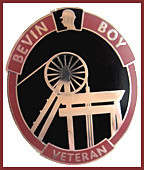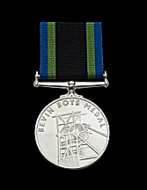
Who Were The Bevin Boys?
THE FORGOTTEN CONSCRIPTS
By Warwick H Taylor, MBE,
Former Vice President of The Bevin Boys Association
These young men could well be described as having served in the secret underground
movement during the Second World War, but not in the sense that most people would imagine, for even today many have not heard of the term Bevin Boy.
Sixty eight years ago on the 2nd December 1943, Ernest Bevin the wartime Minister of Labour and National Service announced in the House of Commons a scheme that was to change the lives of many young
men, by being directed to serve their National Service working underground in the coal mines of Britain.
When war was declared against Germany
in September 1939, a large number of experienced miners were called up into the Forces, with others leaving to take up work in other
higher paid industries. In the years leading up to 1943 various schemes were set up to recruit labour and thus increase coal production vital to the needs of the nation.
The release of ex miners in the Home Forces, the recall of retired miners, unemployed and young boys of school leaving age to make a career in coal mining were all tried, proving to be unsuccessful.
The only way of overcoming this serious situation was to conscript an additional 50,000 men to work underground in
the coal mines over a period of eighteen months.
The system employed by the Minister was that of a ballot scheme whereby young men between the ages of 18 and 25 years, upon registering for National Service, would be selected according to the last
digit of his registration number. Numbers would be drawn on a fortnightly basis with the first being drawn in the Minister's Office on the 14th December. The fact of having received any form of
pre-service training in a Cadet Force would not grant the right for any exemption. Any refusal to comply with the Direction Order would inevitably result in a heavy fine or possible imprisonment
under the Emergency Powers Act in force at the time.
Not all Bevin Boys were ballotees, as many had the opportunity at the time of call-up of choosing this form of employment in lieu of service in the Armed Forces and were so classified as Optants or
Volunteers. However it. must be clearly stated that Bevin Boys were not Conscientious Objectors because of this decision, an unfortunate stigma that has been a bone of contention ever since.
After medical examinations, travel warrants and instructions quickly followed to report to one of the thirteen Government Training Centre Collieries in England, Wales and Scotland.
Upon arrival at the assigned destination, a Ministry of Labour Official would allocate accommodation in either a purpose built Miners Hostel similar to an army camp, or billeted out to a private home
all at a cost of £1.25 (twenty five shillings) per week deducted from an average wage of £3.50 (three pounds, ten shillings).
Training would last for a duration of four weeks and take the form of classroom lectures, surface and underground training as well as physical training, when at the end of this period allocation
would be made to a colliery normally within the same region, where again accommodation would be similar to those at the training centre.
Bevin Boys were issued with a safety helmet, overalls and a pair of steel capped boots and like other miners carried a heavy miner’s safety lamp, a snap tin containing sandwiches and a water
bottle.
The lamp would first be issued from the lamp room on production of a brass lamp check or token followed by a contraband search by the Banksman who was in charge of cage movements on the surface, to
make sure that no person was concealing tobacco, cigarettes, matches or lighters all of which being strictly forbidden for obvious reasons with the ever present risk of explosion from methane gas or
firedamp. The main purpose of the lamp is to detect any presence of gas although providing light.
Doubtless a Bevin Boy will never forget the initiation drop in the cage causing heavy pressure on the ear drums and possible nose bleeds. Upon emerging from the cage after descending anything up to a
mile deep into the earths interior, invariably followed by a long walk on uneven terrain to finally arrive to work in dangerous and cramped conditions. However the majority of Bevin Boys worked on
haulage or conveyor belts with only a few graduating to work on the coal face.
Most forms of haulage involved the use of cables for the movement of tubs or drams as they were known in Wales and in some collieries pit ponies were used. A pony would be an invaluable friend in the event of a miner’s safety lamp going out, to find a frightening situation of
being in total darkness and a considerable distance from the pit bottom, by holding on to the tail of the pony, would lead the unfortunate miner back to safety. Pit ponies were stabled underground
for life at some 90 collieries, whereas others would allow them to come up to the surface for one week during the annual holiday period when the pit was closed.
Understandably the Bevin Boy was looked upon with suspicion by the regular miners who were suddenly faced with an invasion of young inexperienced men many who had never got their hands dirty in their
lives and were forced into an industry in which they had no wish to be. Miners relied on bonuses earned by hard work, and would not relish working alongside a Bevin Boy who showed a complete lack of
interest and did not pull his weight. Fortunately these fears and suspicions were soon dispelled proving their capability in spite of considerable absenteeism.
The work was hard in appalling conditions with no toilet facilities, working in areas that were hot, cold, wet, draughty, dusty, dirty and smelly. The constant noise of machinery was also deafening
with daily hazards of enduring cuts and bruises. Dangers and risks were numerous, with always the fear that perhaps there might be an explosion resulting in fire or even a rock
fall.
Allocation of jobs would normally be made by the Deputy, the official name given to
the person in charge and it was always good policy to keep on the right side of him in order to avoid being allocated an unpopular job.
At the end of a shift a rush would be made back to pit bottom where the person in charge of the cage movements known as the Onsetter would control the awaiting queue to get back into the fresh air
and civilisation.
Some of the larger collieries had pit head baths in order to shower and change into clean clothes, but where facilities were not provided it would mean going back to the hostel or billets.
The Bevin Boy did not have a uniform and therefore only wore civilian clothes when off duty, which attracted considerable attention from the public prompting adverse remarks as to why not being in Navy, Army or Air Force uniform. Also being of military age, prompted suspicion as either being a draft dodger or deserter from the Forces or possible enemy agent with frequent challenging by the local Police.
With the ending of the Second World War in Europe, eventually a release scheme was introduced similar to that of the Forces, but Bevin Boys received no form of recognition or reward for their services to the war effort in which they played a vital part.
Whilst serving, all servicemen enjoyed NAAFI facilities with concessionary tobacco and cigarette rates and confectionary rations. When released from the Forces were allowed to keep their uniforms, kitted out with a demobilisation outfit, granted several weeks leave and received campaign medals. Also it was a mandatory requirement for civilian occupations to be held open to returning ex servicemen.
None of these applied to the Bevin Boys who were clearly identified as "civilians" and not servicemen in spite of all serving under the title of National Service.
A small number of Bevin Boys formed an Association during the war, but stood little chance of success due to lack of communication being isolated in different parts of the United Kingdom and the gradual
release from the coal mining industry.
It was not until 50 years later that a handful of Bevin Boys decided to form the Bevin Boys Association in
1989.
In 1998 the Bevin Boys Association was granted the honour of parading in the Remembrance Day Parade at the Cenotaph in
London, being the only civilians apart from London Transport allowed to participate, which has now become an annual event.
Further recognition followed in 2000 when HM. The Queen unveiled The Home Front Memorial in Coventry to commemorate the role of all civilians including Bevin Boys who served the Nation during WWII.
Today, with the decline of the coal mining industry, the Bevin Boy will not be forgotten and has become part of our coal mining history.
I shall never forget my time working as one of the 50,000 Bevin Boys, or for the respect for the miners with whom I worked with in South Wales.
W Taylor


